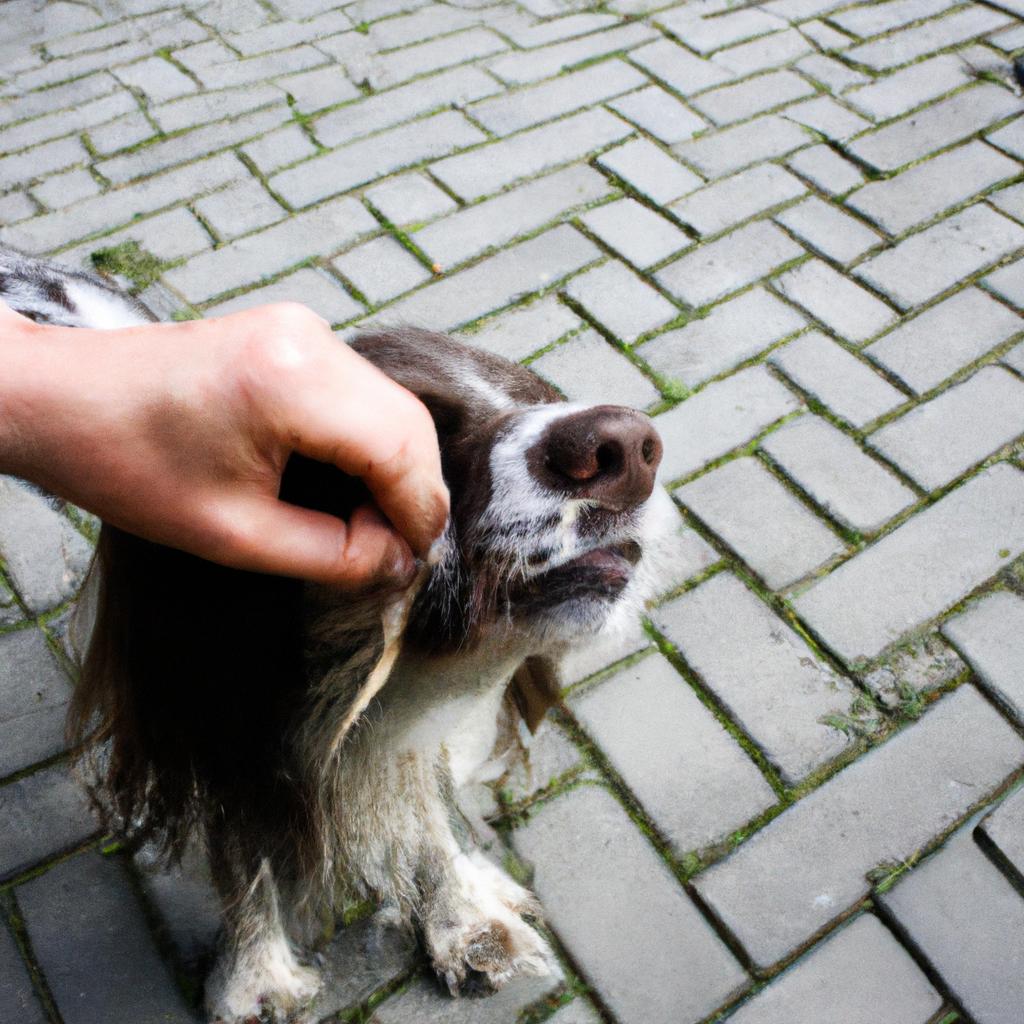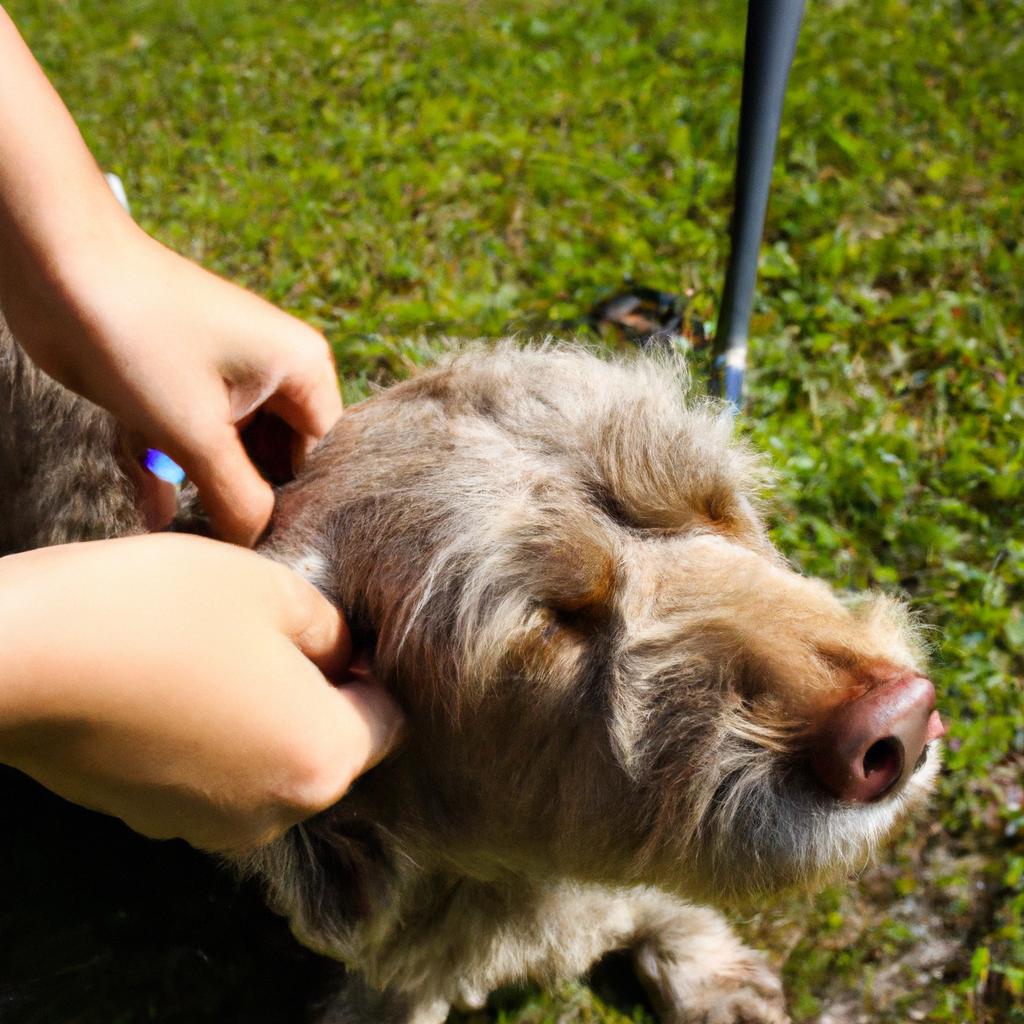Eye Care in Dog Grooming Salon: Essential Tips for Ear Cleaning

Dog grooming is an essential aspect of pet care, ensuring the overall well-being and hygiene of canine companions. Among the various tasks involved in dog grooming, ear cleaning holds significant importance. Neglecting proper ear care can lead to a range of issues such as infections, discomfort, and even hearing loss for our furry friends. To highlight the significance of eye care in dog grooming salons specifically regarding ear cleaning, this article aims to provide essential tips and techniques that groomers can implement to ensure optimal ear health for dogs.
In order to emphasize the relevance of appropriate eye care in dog grooming salons, let us consider a hypothetical case scenario. Imagine a small terrier named Max who frequently visits his local grooming salon for routine maintenance. One day during his appointment, while getting his ears cleaned by a professional groomer, Max experiences extreme discomfort and exhibits signs of distress. Upon further examination, it is discovered that Max’s ears have been mishandled during the process due to improper technique or lack of attention. This unfortunate incident highlights the need for trained professionals in dog grooming salons who possess knowledge about proper eye care practices when it comes to ear cleaning procedures.
Therefore, understanding the right methods and precautions associated with ear cleaning is crucial for maintaining the health and happiness of our canine companions. Here are some essential tips and techniques for groomers to ensure optimal ear health during the ear cleaning process:
-
Proper Inspection: Before starting the ear cleaning procedure, it is important to thoroughly inspect the dog’s ears for any signs of redness, swelling, discharge, or odor. These can indicate an underlying infection or issue that may require veterinary attention.
-
Gentle Approach: When handling a dog’s ears, always be gentle and cautious to avoid causing discomfort or injury. Use slow and deliberate movements while holding the ear flap to prevent any sudden jerks or pulls.
-
Choosing the Right Products: Selecting appropriate products for ear cleaning is vital. Groomers should use veterinarian-recommended ear cleaners specifically formulated for dogs. Avoid using cotton swabs or other sharp objects that could potentially damage the delicate structures inside the ear.
-
Proper Technique: To clean a dog’s ears, start by applying a small amount of the recommended ear cleaner onto a cotton ball or pad. Gently wipe the inner surface of the ear flap and carefully insert your finger into the canal (avoid going too deep) while massaging in circular motions to help loosen dirt and debris.
-
Recognizing Warning Signs: During the cleaning process, pay attention to any signs of discomfort shown by the dog such as pulling away, shaking their head vigorously, whimpering, or yelping. If these behaviors persist, stop immediately and consult with a veterinarian.
-
Regular Maintenance: It is advisable to include regular ear cleaning sessions as part of a dog’s grooming routine. The frequency may vary depending on factors like breed, activity level, and susceptibility to infections. Consult with a veterinarian for guidance on how often specific dogs should have their ears cleaned.
By implementing these tips and techniques in dog grooming salons, groomers can effectively promote optimal ear health for dogs and prevent potential issues associated with improper eye care practices during ear cleaning procedures. Remember, the well-being of our furry friends should always be a top priority in any grooming salon environment.
Why Proper Ear Care is Important for Dogs
Why Proper Ear Care is Important for Dogs
Imagine a scenario where you notice your beloved furry friend, Buddy, constantly scratching his ear and shaking his head. Concerned about his discomfort, you take him to the dog grooming salon for an ear cleaning session. This simple example highlights the importance of proper ear care in dogs. In this section, we will discuss why maintaining good ear hygiene is crucial for our canine companions.
The Importance of Preventing Infections:
One primary reason to prioritize ear care is to prevent infections. The warm and moist environment inside a dog’s ear canal creates an ideal breeding ground for bacteria, yeast, and other harmful microorganisms. Neglecting regular cleaning can lead to the accumulation of debris and wax, promoting the growth of these pathogens. As a result, dogs are more susceptible to painful and chronic conditions such as otitis externa (outer ear infection).
Ensuring Comfort and Well-being:
Properly caring for a dog’s ears not only prevents infections but also promotes their overall comfort and well-being. Dogs rely heavily on their acute sense of hearing to navigate their surroundings and communicate with humans and other animals. Accumulated dirt or excess wax can obstruct sound waves from reaching their eardrums effectively, potentially causing temporary hearing loss or impairments that affect their daily activities.
Bullet Point List – Emotional impact:
To truly understand the significance of proper ear care in dogs’ lives, consider the following:
- Reduced risk of pain and discomfort
- Improved quality of life through enhanced communication abilities
- Prevention of potential complications requiring expensive veterinary treatments
- Strengthened bond between owners and pets due to increased trust and reliance
Emotional impact:
| Benefits of Proper Ear Care | |
|---|---|
| 1 | Enhanced physical comfort |
| 2 | Improved auditory perception |
| 3 | Financial savings from avoiding costly treatments |
| 4 | Strengthened human-animal bond |
Transition into the next section:
By recognizing the potential consequences of neglecting ear care, we gain a deeper understanding of common ear problems that dogs may encounter. Understanding these issues allows us to take proactive measures and address them promptly, ensuring our furry friends remain healthy and happy companions. In the following section, we will explore some of these common ear problems in detail.
Common Ear Problems in Dogs
Understanding the importance of proper ear care in dogs, it becomes essential to equip ourselves with knowledge on how to effectively clean their ears. By adopting regular ear cleaning practices, we can prevent potential issues and maintain our furry friends’ overall well-being.
To illustrate the significance of proper ear care, let’s consider an example. Imagine a Labrador Retriever named Max who frequently enjoys swimming in lakes. Due to his love for water activities, Max is more prone to developing ear infections caused by excessive moisture trapped within his ears. This case highlights the need for diligent ear cleaning techniques that help prevent such problems.
When it comes to cleaning your dog’s ears, remember these crucial tips:
-
Gather the necessary supplies:
- Cotton balls or gauze pads
- Vet-approved ear cleanser
- Towel or tissue paper
-
Approach gently and carefully:
- Start by calming your pet before commencing the process.
- Avoid using any objects that may harm or cause discomfort to your dog’s ears.
-
Follow a step-by-step procedure:
- Begin by examining your dog’s ears for signs of redness, swelling, discharge, or odor.
- Pour a small amount of ear cleanser into your dog’s ear canal as instructed by your veterinarian.
- Massage the base of the ear gently to distribute and loosen any debris.
- Allow your dog to shake their head naturally after applying the cleanser.
- Use cotton balls or gauze pads to wipe away visible dirt and excess liquid from the outer part of the ear canal. Be cautious not to insert anything deep into the ear canal.
-
Establish a regular cleaning routine:
- Consistency is key in maintaining healthy ears for your dog.
- Consult with your veterinarian to determine the optimal frequency of ear cleaning based on your pet’s specific needs.
By adhering to these essential tips, you can ensure proper ear hygiene and reduce the likelihood of ear problems in your beloved canine companion.
Understanding how to clean your dog’s ears is vital in identifying potential issues early on. By being attentive to signs of discomfort or abnormalities during the process, we can promptly address any emerging concerns. Let’s now explore some common indicators that may suggest an ear infection in dogs.
Signs of Ear Infections in Dogs
Ear infections are a common problem in dogs and can cause discomfort, pain, and even hearing loss if left untreated. Identifying the signs of an ear infection is crucial for early intervention. In this section, we will explore the various signs that indicate an ear infection in dogs.
Imagine a scenario where Max, a Labrador Retriever, starts scratching his ears excessively and shaking his head vigorously. These behaviors could be indicative of an underlying ear infection. Other signs to watch out for include redness or swelling of the outer ear, a foul odor coming from the ears, and discharge or wax buildup.
To further understand the signs of an ear infection, let’s delve into some key indicators:
- Scratching: Dogs with ear infections often scratch their ears repeatedly due to irritation.
- Head Shaking: If your dog frequently shakes its head from side to side, it may be trying to relieve discomfort caused by an inflamed inner ear.
- Tilting or Holding Head to One Side: This behavior may suggest that your dog is experiencing pain or balance issues associated with an ear infection.
- Sensitivity to Touch: Dogs with infected ears might exhibit sensitivity when their heads or ears are touched.
Consider the following table summarizing these signs:
| Sign | Description |
|---|---|
| Excessive Scratching | Repeatedly scratching at the affected ear(s) |
| Frequent Head Shaking | Vigorous back-and-forth movement of the head |
| Abnormal Head Position | Tilted head or consistently holding head tilted toward one side |
| Ear Sensitivity | Discomfort or pain upon touching or examining the ears |
Recognizing these symptoms promptly allows pet owners to seek veterinary attention and ensure appropriate treatment for their furry companions. Once you have identified potential signs of an ear infection in your dog, it becomes essential to take preventive measures for maintaining good ear health.
Transitioning into the subsequent section about “Preventive Measures for Ear Care in Dogs,” it is crucial to follow a consistent ear care routine to minimize the risk of infections and maintain your dog’s overall well-being.
Preventive Measures for Ear Care in Dogs
Having discussed the signs of ear infections in dogs, it is crucial to understand the preventive measures necessary for maintaining good ear care. By implementing these practices, dog owners and groomers can effectively reduce the risk of their furry friends developing painful ear infections. Let’s explore some essential tips for preventing ear problems in dogs.
Paragraph 1:
To begin, regular inspection of a dog’s ears is key to early detection and prevention of potential issues. For instance, imagine a scenario where an owner notices redness and excessive scratching around their dog’s ears during routine grooming. Upon closer examination, they find a foul odor emanating from the ears, indicating a possible infection. By promptly addressing this issue and seeking veterinary assistance if necessary, the owner can prevent further discomfort for their canine companion.
- Keep your dog’s ears clean by gently wiping them with a veterinarian-recommended cleaning solution.
- Ensure that excess hair inside the ears is regularly trimmed to allow better airflow.
- Avoid exposing your dog’s ears to excessive moisture or water while bathing or swimming.
- Regularly check for foreign objects like grass seeds or ticks that may have lodged themselves within the ear canal.
| Common Causes of Ear Infections | Signs & Symptoms | Preventive Measures |
|---|---|---|
| Allergies | Head shaking | Routine inspections |
| Excessive wax production | Redness | Cleaning solutions |
| Moisture buildup | Odor | Proper hair trimming |
| Foreign objects | Scratching | Protection from water |
Paragraph 2:
In addition to thorough inspections, proper hygiene plays a vital role in preventing ear infections. A consistent cleaning routine helps remove dirt, debris, and excess wax that could potentially lead to bacterial growth. It is important to note that each breed may require specific cleaning techniques; therefore, consulting with a professional groomer or veterinarian regarding appropriate methods is advisable. By prioritizing cleanliness, dog owners can significantly reduce the risk of ear infections and promote overall ear health in their pets.
Paragraph 3:
By incorporating regular inspections and maintaining proper hygiene practices, dog owners and groomers can effectively prevent many common ear problems. However, it is crucial to remember that some dogs may be more prone to developing ear issues due to factors like breed or underlying health conditions. Therefore, seeking guidance from a veterinarian when concerns arise is always recommended.
With these preventive measures in mind, let us now explore the best practices for cleaning your dog’s ears while promoting their overall well-being.
Best Practices for Cleaning Dog’s Ears
Imagine a scenario where a dog owner brings their beloved pet to a grooming salon, and upon closer inspection, the groomer notices signs of ear discomfort. The dog’s ears are red, swollen, and emit an unpleasant odor – all indicators of potential ear issues. In such cases, it is crucial for professional groomers to be equipped with essential tips for proper ear cleaning. By following preventive measures, groomers can help maintain healthy ears in dogs.
To ensure effective ear care in dogs, here are some key practices that every dog grooming salon should implement:
-
Regular Inspection: Routine examination of a dog’s ears allows early detection of any abnormalities or signs of infection. Groomers should carefully inspect both the external and internal parts of the ears during every grooming session.
-
Gentle Cleaning Process: When cleaning a dog’s ears, using appropriate products specifically formulated for canine use is imperative. Avoid harsh chemicals or excessive force while cleaning as these may cause irritation or injury to the delicate structures within the ear canal.
-
Proper Technique: Trained professionals should follow recommended techniques when cleaning a dog’s ears to ensure thorough yet gentle removal of debris and wax buildup. This includes holding the pinna (ear flap) upright while applying cleanser and gently massaging the base of the ear to dislodge any accumulated material.
-
Maintaining Hygiene: Consistently maintaining cleanliness throughout the grooming process helps prevent cross-contamination between dogs’ ears and reduces the risk of spreading infectious agents.
By implementing these preventive measures, groomers create an environment conducive to proper ear care in dogs at their salons. However, despite meticulous efforts, there may still be instances when grooming alone cannot address certain ear issues adequately.
Transitioning into “When to Seek Veterinary Help” section
When to Seek Veterinary Help for Ear Issues in Dogs
Building upon the best practices discussed earlier, it is crucial to understand when professional veterinary assistance should be sought if any ear issues arise during the grooming process. Consider the following case study as an example:
Case Study:
Imagine a scenario where a dog named Max visits a grooming salon for routine ear cleaning. Despite employing appropriate techniques and using gentle products, Max exhibits signs of discomfort during the procedure. His ears become red and swollen, with excessive scratching and head shaking persisting even after many days.
Understanding When to Seek Veterinary Help:
-
Prolonged or Severe Symptoms:
If you notice persistent symptoms such as frequent itching, foul odor, discharge, pain, or swelling lasting longer than a few days post-grooming session, it is essential to consult a veterinarian promptly. These could indicate underlying conditions like infections, allergies, polyps, or foreign bodies that require medical attention. -
Changes in Behavior:
Keep an eye out for any behavioral changes exhibited by your dog after ear cleaning sessions. If you observe increased irritability or aggression towards touch around their ears or head area following grooming procedures, consulting a veterinarian can help identify potential causes and provide necessary treatment options. -
Recurring Issues:
In cases where your dog experiences recurring ear problems despite adhering to proper cleaning techniques at home or visiting reputable groomers regularly, seeking veterinary assistance becomes imperative. Chronic inflammation or recurrent infections may point towards an underlying health condition requiring specialized care.
Emotional Bullet Point List
- Protect Your Furry Friend: Seeking timely veterinary help ensures early detection and intervention for potential ear issues.
- Relieve Discomfort: Professional advice can alleviate pain caused by infections or other ailments affecting your dog’s ears.
- Prevent Further Complications: Early intervention minimizes the risk of more severe complications, such as hearing loss or chronic ear problems.
- Peace of Mind: Consulting a veterinarian provides reassurance and expert guidance in maintaining your dog’s overall ear health.
Emotional Table (markdown format):
| Benefits of Veterinary Assistance for Ear Issues |
|---|
| 1. Timely detection and early intervention |
| 2. Professional advice on alleviating discomfort |
| 3. Prevention of further complications |
| 4. Reassurance and peace of mind for pet owners |
In summary, if you notice prolonged or severe symptoms, changes in behavior after grooming sessions, or recurring issues with your dog’s ears despite proper care, seeking veterinary assistance is essential. By understanding when to involve professionals, you can ensure optimal ear health for your beloved canine companion. Remember that timely interventions not only alleviate discomfort but also prevent potential long-term complications associated with untreated ear problems.




